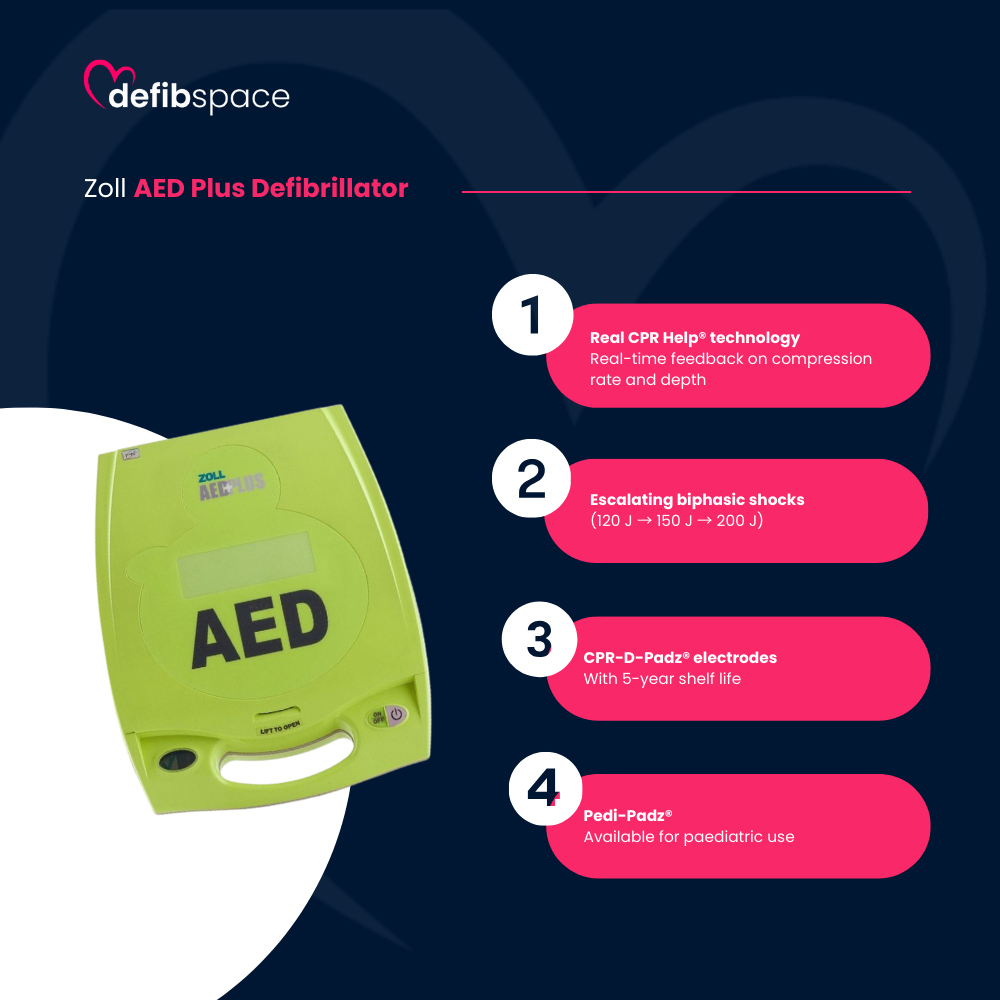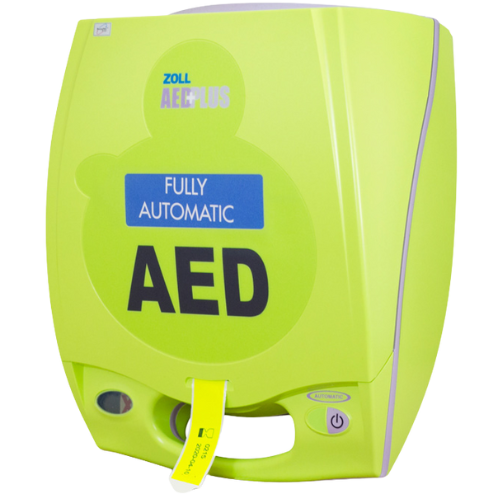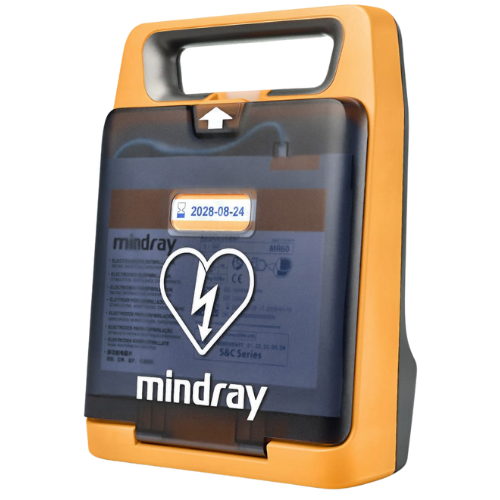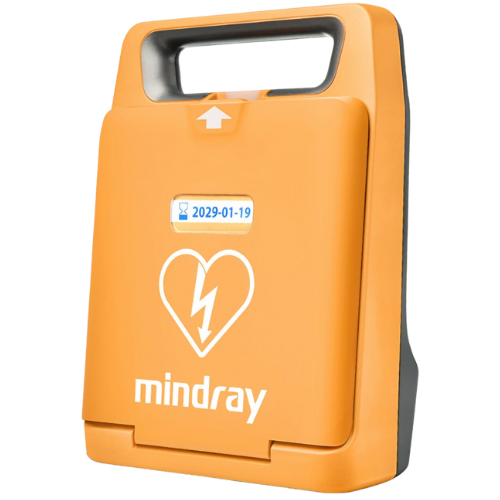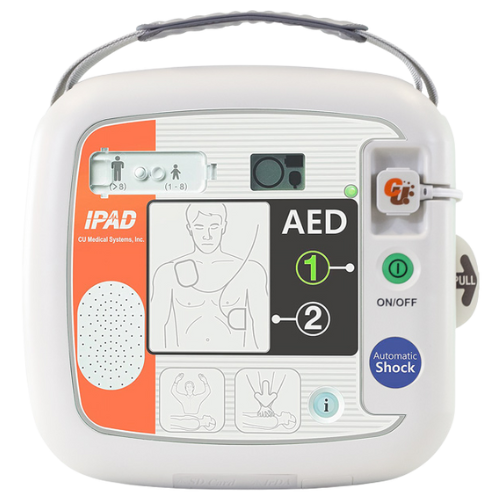Village Hall & Parish AED Schemes in 2025
Village halls and parish-owned buildings are often the centre of rural life in the UK. They host local meetings, community events, and gatherings where people of all ages come together. Because these spaces are well used, they are also important locations for public access to life-saving equipment such as automated external defibrillators (AEDs).
An AED is a portable device that can analyse a person’s heart rhythm and deliver an electric shock if needed to help restore a normal rhythm during sudden cardiac arrest. When someone experiences a cardiac arrest, every minute without defibrillation reduces their chance of survival by roughly 10%. Quick access to an AED can therefore mean the difference between life and death.
In recent years, parish and town councils across the UK have increasingly supported the installation of AEDs on or near village halls. These schemes ensure that residents and visitors have access to a defibrillator 24 hours a day, particularly in areas where ambulance response times may be longer.
Did You Know?
According to the British Heart Foundation, fewer than 1 in 10 people survive an out-of-hospital cardiac arrest in the UK, but survival rates can triple when an AED is used before emergency services arrive.
A visible, well-maintained AED at a village hall can serve not only the building’s users but the entire local community. It demonstrates preparedness and a shared commitment to saving lives.
Regulatory & Legal Context in the UK
Installing and maintaining a defibrillator within a village hall or parish scheme does not require special approval from national authorities, but organisers must follow relevant health and safety and public liability guidance. Understanding the legal context helps ensure the AED can be used confidently and safely.
Legal Use and Liability
Anyone can use an AED in an emergency. The device gives clear voice prompts and will only deliver a shock when needed. UK law supports the concept of a “Good Samaritan” - meaning that a person who acts in good faith to help someone in cardiac arrest is highly unlikely to face legal consequences if they use an AED.
Both the Resuscitation Council UK and the Health and Safety Executive (HSE) confirm that members of the public can safely and legally use a defibrillator without formal medical training. The equipment is designed for public use, and misuse is extremely rare.
Guidance and Best Practice
The Resuscitation Council UK and British Heart Foundation provide best-practice advice on AED installation, signage, and maintenance. Their guidance recommends that public-access AEDs should be:
Highly visible and accessible at all times
Registered with emergency services via The Circuit (the national AED network)
Checked regularly by a nominated guardian or responsible person
Local Authority and Insurance Considerations
Parish or town councils installing AEDs on their property should:
Inform their insurance provider to ensure the AED and cabinet are covered for theft or damage
Check with the building owner (if the hall is leased or managed by a trust) for written permission before wall installation
Ensure electrical work for heated outdoor cabinets is carried out by a qualified electrician
In addition, some councils now include AED schemes within their public health or community resilience policies, meaning funding or technical support may be available locally.
Observation: In many parish halls, cabinets are installed near the main entrance under exterior lighting. This improves visibility and allows easy access at night without unlocking the building, a small but important detail that improves public confidence and response speed.
Assessing Need & Coverage
Before installing an AED, parish councils and community groups should assess how it will serve their local area. Understanding demand, location coverage, and accessibility ensures that the device provides genuine benefit to residents and visitors.
Identifying Local Risk Factors
Certain factors increase the importance of AED access in a rural or village setting:
Distance to emergency response: Ambulance response times are typically longer in rural areas.
Population demographics: Older populations or areas with high footfall from community events increase potential cardiac risk.
Public gathering points: Village halls, churches, playing fields, and pubs are key locations where cardiac arrests are statistically more likely to occur.
Mapping these factors helps determine the most strategic location for installation.
Mapping Existing Coverage
Before purchasing or installing a new AED, communities should check for existing nearby devices. The Circuit, the British Heart Foundation’s national defibrillator network, allows users to search for registered AEDs across the UK. If one is already nearby and accessible 24/7, it may be better to focus resources on improving visibility, signage, or community training rather than adding a duplicate device.
Defining the Coverage Area
A public access AED typically provides effective coverage within a two- to three-minute walking radius, which translates to about 200–300 metres. This timeframe is important because each minute without defibrillation reduces survival chances by roughly 10%.
When mapping out potential sites, communities should consider:
Accessibility day and night (is it outside and unlocked?)
Visibility from main roads and footpaths
Lighting and signage to guide responders quickly
Proximity to power supply if using a heated cabinet
Consulting Local Services
Some ambulance trusts offer mapping assistance to identify AED “gaps” in their response zones. Local first responder groups or public health teams can also provide useful data on cardiac arrest incidents in the area.
Did You Know?
The British Heart Foundation reports that more than 50,000 cardiac arrests occur out of hospital in the UK every year - many in locations without a defibrillator nearby.
Funding & Financial Models
Funding is often the main challenge for parish and village hall AED schemes. Fortunately, a mix of national grants, community fundraising, and flexible rental options now makes access far more achievable than in the past.
National and Regional Grant Programmes
The UK government and several health charities continue to fund public access defibrillators. Examples include:
Department of Health and Social Care (DHSC) Community AED Fund: Supports installation in community spaces such as village halls and sports clubs.
British Heart Foundation (BHF) Partnerships: Offers partial funding or supply support for eligible community projects.
Regional ambulance service grants: Some local NHS Trusts run small-scale schemes to co-fund AEDs and cabinets for rural areas.
Information about current programmes can be found at defibgrant.co.uk, which lists ongoing national funding initiatives and eligibility details.
Parish Council and Community Contributions
Many AEDs are purchased through a mix of parish budgets, local business sponsorship, and resident fundraising. Common methods include:
Annual community events or raffles
Donations from local charities or Rotary clubs
Allocating a small portion of parish precept funds
The key is to plan for both initial purchase and long-term upkeep, as electrode pads and batteries need replacing every few years.
Renting or Leasing an AED
An increasingly popular approach is defibrillator rental, which spreads the cost and includes maintenance.
Providers such as Defib Space offer fully managed packages for businesses and communities, including installation, servicing, replacement pads and batteries, and 24/7 support, from as little as £1 per day.
This approach eliminates large upfront costs and ensures equipment remains operational without relying solely on volunteers. For smaller parish councils or community trusts with limited budgets, rental can be a cost-effective and sustainable option.
In-Kind and Volunteer Support
Many communities reduce costs through in-kind help. Local electricians may volunteer installation time, and volunteers can take responsibility for regular visual checks. Councils can also collaborate with local emergency response teams to share data and maintenance tasks.
Observation: Successful parish AED projects often start with a motivated resident or small committee who coordinate grant applications and sponsorship. Their local knowledge helps target funding sources and ensures broad community backing.
Device, Cabinet & Placement Considerations
Selecting the right equipment and location is essential to ensure an AED can be accessed quickly, safely, and reliably when needed. Parish councils and village hall committees should focus on visibility, durability, and ease of use.
Choosing the Right AED
Modern AEDs are designed for simplicity and reliability. For community use, it is best to choose a fully automatic model, one that delivers a shock automatically when required, to reduce hesitation during emergencies.
Key features to consider include:
Clear voice and visual prompts for untrained users
Long battery and pad life (some models last up to five years)
Self-testing capability to ensure readiness
Compatibility with adult and child electrode pads
Manufacturer warranty and support availability
Models such as the ZOLL AED Plus and Mindray BeneHeart C1A are commonly used in UK community schemes because they meet these criteria and are easy to maintain.
Cabinet Options
Outdoor cabinets protect AEDs from weather and vandalism. Key considerations include:
Heated and thermostatically controlled units for year-round protection
Locking mechanisms - some areas prefer code-locked cabinets, while others opt for unlocked units to speed up access
Visibility - cabinets should be brightly coloured (usually yellow or green) with clear signage
Durability - choose cabinets made from corrosion-resistant materials with IP-rated seals
Power supply is required for heated cabinets, so installation should be carried out by a qualified electrician.
Optimal Placement
AEDs should be accessible 24 hours a day, ideally mounted on an external wall of the village hall facing a road or car park. Other good locations include:
The main entrance under exterior lighting
A sheltered wall within public reach but away from obstructions
Near a telephone box or noticeboard, where signage can be added
The recommended height for mounting is between 1.0 and 1.5 metres from the ground, making it usable for all ages and abilities.
Signage and Lighting
Clear signage improves visibility and public awareness. The international AED symbol (a heart with a lightning bolt) should appear on the cabinet and nearby walls. Directional signs from main paths or car parks further reduce search time.
Did You Know?
Research by the Resuscitation Council UK found that AEDs placed outside and clearly marked are used up to three times more often than those stored indoors or without visible signage.
Governance, Maintenance & Sustainability
Once an AED is installed, it must remain in reliable working order. Establishing clear governance and maintenance routines ensures that the device is always ready for use and compliant with manufacturer and ambulance service expectations.
Assigning Responsibility
Every community AED should have an appointed guardian or responsible person. This role is often taken on by a parish councillor, hall committee member, or trained volunteer. The guardian’s duties typically include:
Conducting weekly visual checks of the AED and cabinet
Confirming that indicator lights show the unit is operational
Recording inspections in a simple log sheet or online tracker
Reporting any issues (e.g., low battery, damaged pads, or vandalism)
Some ambulance trusts offer online portals to record maintenance checks and support compliance tracking.
Routine Checks and Replacement Schedule
AEDs perform self-tests automatically, but manual oversight remains vital. Most models indicate faults using flashing lights or audible beeps. Key components that require periodic replacement include:
Electrode pads: typically every 2–5 years, depending on brand
Batteries: usually every 4–5 years, or sooner after use
Cabinet heating elements: checked annually for outdoor installations
It is good practice to store spare pads and ensure all replacements are from the same manufacturer.
Servicing and External Support
Maintenance can be managed locally or through service contracts. Many councils opt for rental or managed AED schemes, such as those provided by Defib Space, which include:
Regular checks and replacement parts
24/7 support and call-out assistance
Automatic replacement following deployment
This approach reduces reliance on volunteers and ensures consistent standards across multiple parish sites.
Sustainability and Long-Term Management
Parish councils should budget for ongoing costs at the planning stage. Sustainable AED programmes depend on:
Clear handover procedures if volunteers move on
Secure funding for replacement parts
Annual reporting to the council or trust board
Periodic training refreshers and community engagement
Insurance and Security
Notify your insurer that an AED is installed. Most public liability policies will include cover for accidental damage or misuse, but theft and vandalism protection should also be confirmed. Installing motion sensors or lighting near outdoor cabinets can deter vandalism.
Observation:
In some rural parishes, small signs inside the hall remind regular users to visually check the AED cabinet on their way out. This informal habit strengthens shared responsibility and keeps the device visible to the whole community.
Registration & Integration with Emergency Services
Registering your AED with the UK’s emergency network ensures that it can be located and accessed by anyone calling 999. Without registration, ambulance control centres will not be able to direct callers to your defibrillator, even if it is installed and fully operational.
Registering with The Circuit
The Circuit is the British Heart Foundation’s national defibrillator network, developed in partnership with the Resuscitation Council UK, St John Ambulance, and the Association of Ambulance Chief Executives. It links AED locations directly with all UK ambulance services.
When registering your device at thecircuit.uk, you’ll be asked to provide:
The exact location and access details (for example, “on the outer wall of the village hall, near the main entrance”)
Availability hours - ideally “24 hours” for outdoor installations
Guardian contact information for maintenance reminders
Serial number and model of the AED
Registration is free and only takes a few minutes. Once approved, your AED will appear on the ambulance dispatch system and in many public AED mapping tools.
Working with Local Ambulance Services
After registration, confirm with your regional ambulance trust that the AED appears correctly in their system. This step ensures dispatchers can direct callers to the correct location during emergencies. Many trusts will also send periodic update reminders to guardians.
Some areas run Community Responder Schemes, where volunteers are trained to use AEDs and perform CPR while waiting for emergency services. Linking your AED with these networks improves coverage and ensures it is part of the local response plan.
Mobile Applications and Public Mapping
Beyond The Circuit, AEDs can also appear in public mapping apps such as GoodSAM or Save a Life. These apps show live locations of registered defibrillators and can help responders find the nearest one quickly. However, registration with The Circuit remains the official and most important step for emergency response integration.
Information Sharing and Updates
Each time your AED is moved, serviced, or temporarily unavailable, you must update its status on The Circuit. This ensures dispatchers only direct callers to working devices. Guardians typically receive reminder emails every few months to confirm details.
Did You Know?
According to the British Heart Foundation, thousands of AEDs in the UK are not registered, meaning emergency services cannot see them during cardiac emergencies. Registration can make a critical difference in response times.
Community Engagement & Training
Even the best-placed AED will only save lives if people know it exists and feel confident to use it. Community engagement and education are key to ensuring local residents understand how to act during a cardiac emergency.
Raising Awareness
After installation, parish councils and hall committees should inform the community through:
Local newsletters or parish magazines announcing the AED’s location and access details
Social media updates with photos and clear directions
Village noticeboards or posters at key sites such as shops, pubs, and churches
Launch events or open days, which give residents a chance to see and handle the device
Consistent communication helps normalise AED use and reinforces that anyone, regardless of medical background, can use one safely.
Community Training Sessions
While no formal training is required to use an AED, basic awareness sessions build confidence. Many local ambulance trusts, charities, and organisations like St John Ambulance offer CPR and AED familiarisation courses free of charge or at low cost.
These sessions typically last less than an hour and teach:
How to recognise cardiac arrest
How to call 999 effectively
How to perform hands-only CPR
How to follow AED voice prompts step by step
Village halls are ideal venues for such sessions, as they provide an accessible and familiar learning environment.
Partnerships and Local Involvement
Collaborating with schools, youth groups, and sports clubs can increase engagement. Some communities run “Defib Awareness Days” where younger residents help spread information to families and neighbours.
Parish councils can also partner with nearby first responder teams or NHS community engagement officers to strengthen local readiness.
Ongoing Communication
Awareness fades over time, so it’s important to refresh communication at least annually. Consider short updates during parish meetings, local fetes, or online forums. Including AED checks and training reminders in hall newsletters helps sustain public attention and participation.
Observation: Villages that display clear AED signage both on the hall and along main roads tend to see higher awareness levels. In several rural areas, reflective signs or solar lighting have made cabinets easier to spot at night, a simple but effective improvement.
Case Studies & Examples
Real-world examples from UK parishes highlight how AED schemes can be successfully planned, funded, and maintained at a community level. These projects demonstrate that even small villages can implement reliable, sustainable access to defibrillators when local coordination and awareness are prioritised.
Example 1: Stondon Parish Council (Bedfordshire)
Stondon Parish Council installed several defibrillators across its community, including one on the exterior of the village hall. The parish used local fundraising alongside council funds to cover both the AED and cabinet costs.
Key aspects of their success included:
A clear maintenance plan with designated guardians
24/7 outdoor access with lighting and signage
Public updates through parish newsletters and a dedicated web page (stondon-pc.gov.uk)
This transparency helped maintain long-term community support and encouraged volunteers to take responsibility for regular checks.
Example 2: Cumbrian Village AED Partnership
In several rural Cumbrian parishes, councils collaborated to share the cost of multiple AEDs across village halls and telephone boxes. Each unit was registered with The Circuit and maintained through a joint rota of volunteers.
This cooperative approach reduced individual council costs and ensured coverage across multiple villages rather than isolated efforts.
Example 3: Rental Approach for Smaller Communities
Some small parish halls have chosen to rent AEDs rather than buy them outright. This model, used in schemes supported by Defib Space, allows for:
No large upfront costs
Regular servicing and automatic part replacement
Equipment upgrades when new technology becomes available
This has proved particularly useful for parishes with limited budgets or where volunteers may change frequently. It also guarantees reliability without adding administrative workload.
Lessons Learned from Community Projects
Visibility matters most. AEDs placed outside and signposted are far more likely to be used.
Shared responsibility works. Appointing multiple guardians prevents maintenance lapses.
Engagement sustains funding. Annual community events or small donations maintain enthusiasm and cover ongoing costs.
Integration saves lives. Registering with The Circuit ensures 999 operators can direct callers immediately to the device.
Did You Know?
Some parishes have successfully repurposed old red telephone boxes into weatherproof AED cabinets, a practical and symbolic way to preserve local heritage while improving public safety.
Risks, Challenges & Mitigation
While AED schemes in villages and parishes bring clear benefits, they also require careful planning to address practical and long-term challenges. Anticipating these risks ensures the defibrillator remains functional, visible, and accessible for years to come.
Vandalism and Theft
Although uncommon, vandalism and theft do occur, particularly when AEDs are installed in unsupervised outdoor areas.
Mitigation measures include:
Choosing robust, lockable or coded cabinets
Installing motion-sensor lighting or CCTV coverage near the site
Adding clear signage explaining that the AED is for emergency use only
Registering the AED’s serial number and marking it as property of the parish council
Insurance cover should include theft and malicious damage to minimise financial loss.
Power Supply and Environmental Factors
Outdoor AED cabinets need a consistent power source to maintain heating elements, which protect the device from freezing.
Mitigation measures include:
Using a qualified electrician for installation
Periodically testing the power supply and heater function, especially in winter
Installing a temperature indicator to ensure safe conditions
Unheated cabinets can be suitable in milder climates but require sheltered placement and regular inspection.
Maintenance Lapses
Without a structured system, AED checks may be overlooked, leading to expired pads, drained batteries, or undetected faults.
Mitigation measures include:
Assigning multiple trained guardians for oversight
Keeping digital maintenance logs or reminders via The Circuit
Scheduling annual audits as part of parish risk assessments
Rental or managed AED services, such as those provided by Defib Space, can eliminate this risk by including regular inspections and automatic replacement parts.
Volunteer Turnover
Community AED projects often rely on volunteers, who may step down over time.
Mitigation measures include:
Documenting all procedures (checks, reporting, contacts) in a simple handover pack
Including AED management within the parish council’s formal responsibilities
Appointing at least two guardians to ensure continuity
Funding and Long-Term Costs
Initial enthusiasm can wane once the AED is installed, leading to underfunded replacements or expired parts.
Mitigation measures include:
Setting aside a small annual maintenance budget
Holding annual awareness events that double as fundraising opportunities
Considering rental or lease options for guaranteed ongoing coverage
Community Awareness Decline
Awareness tends to decrease if the AED is rarely mentioned or used.
Mitigation measures include:
Refreshing publicity each year via parish communications
Running occasional CPR awareness sessions
Highlighting the AED’s presence during community events or hall bookings
Observation:
In some villages, simply adding a “Defibrillator Here” notice to the parish sign or hall gate has significantly increased public awareness and confidence. Small visual cues help keep the AED visible in residents’ minds.
Next Steps & Checklist for a Parish Looking to Install an AED
Establishing a parish or village hall AED scheme can seem complex, but following a structured approach simplifies the process. The steps below outline how to move from planning to a fully operational and registered defibrillator.
Step 1: Assess Community Need
Identify high-use community locations such as village halls, playing fields, or churches.
Check existing AED coverage using The Circuit or local ambulance data.
Confirm the nearest ambulance response time to justify the installation.
Step 2: Secure Funding
Apply for grants such as the DHSC Community AED Fund or BHF partnerships.
Seek parish precept contributions or local business sponsorship.
Consider Defib Space’s rental model for low-cost, fully managed AED access.
Step 3: Select the Equipment
Choose a fully automatic AED for simplicity and reliability.
Ensure it includes adult and paediatric modes if serving families.
Purchase or rent a weatherproof, heated cabinet suitable for outdoor use.
Step 4: Choose and Prepare the Location
Install the AED on an external wall of the village hall or another 24-hour accessible area.
Check visibility, lighting, and proximity to power supply.
Use professional electricians for cabinet wiring.
Step 5: Assign Roles and Governance
Appoint at least two AED guardians responsible for regular checks.
Keep inspection records in a shared logbook or digital tracker.
Notify the parish council and insurer once installation is complete.
Step 6: Register and Integrate with Emergency Services
Register the device with The Circuit (thecircuit.uk).
Verify that local ambulance dispatchers can access the AED details.
Ensure updates are made whenever the AED is serviced or relocated.
Step 7: Promote Awareness and Training
Announce the installation via parish newsletters, noticeboards, and social media.
Hold a launch event with AED demonstrations or CPR sessions.
Maintain awareness with annual reminders or training days.
Step 8: Maintain and Review
Conduct weekly visual checks and annual audits.
Replace pads and batteries according to the manufacturer’s schedule.
Plan funding for replacements five years ahead.
Quick Checklist
✅ Confirm location and permission
✅ Choose AED and cabinet
✅ Arrange funding or rental agreement
✅ Assign guardians
✅ Register on The Circuit
✅ Notify insurer
✅ Promote and train community
✅ Maintain inspection routine
Did You Know?
Some parish councils have integrated AED checks into their monthly meeting agendas, a simple administrative step that keeps the device at the top of community priorities all year.
Conclusion
Installing a defibrillator at a village hall or parish site is one of the most practical and community-minded safety measures a local council can take. AEDs require minimal training to use, but they deliver significant impact in emergencies, especially in rural areas where ambulance response times can be longer.
By combining careful planning, community engagement, and consistent maintenance, parish AED schemes can provide reliable access to life-saving technology for many years. Registering the device with The Circuit ensures that emergency services can locate it instantly, while involving local residents in awareness and upkeep strengthens the sense of collective responsibility.
Whether purchased outright or rented through a managed provider such as Defib Space, an AED represents a shared investment in public safety. From funding to long-term maintenance, each step can be achieved through collaboration and transparent communication within the community.
Observation: Villages that integrate their AED into everyday visibility, through signage, awareness posters, and mention at local events, maintain stronger engagement and quicker responses when emergencies occur.
Sources & Further Reading
Below are the authoritative sources used to inform this article. Each link provides further verified information or guidance relevant to UK community and parish AED schemes.
Resuscitation Council UK – AEDs (Automated External Defibrillators): Guidance for Public Access Defibrillation Schemes
https://www.resus.org.uk/sites/default/files/2020-03/AED_Guide_2019-12-04.pdf
→ Outlines safe AED use, maintenance recommendations, and community defibrillator best practices.British Heart Foundation – The Circuit: The National Defibrillator Network
https://www.thecircuit.uk/
→ Provides official registration for UK defibrillators and connects AED locations to all ambulance services.Department of Health and Social Care – Community Automated External Defibrillator Fund
https://www.defibgrant.co.uk/
→ Lists current funding schemes and eligibility for community defibrillator projects.Stondon Parish Council – Public Defibrillator Scheme Overview
https://stondon-pc.gov.uk/the-parish/public-defibrillator-or-aed/
→ Example of a successful parish AED installation, including maintenance and communication practices.British Heart Foundation – CPR and Defibrillator Awareness Resources
https://www.bhf.org.uk/how-you-can-help/how-to-save-a-life
→ Provides educational resources for CPR and AED familiarisation training.Health and Safety Executive (HSE) – First Aid at Work: Your Questions Answered
https://www.hse.gov.uk/firstaid/faq.htm
→ Confirms AED use by untrained persons is supported and explains employer and public safety responsibilities.
Source Authority Commentary
Resuscitation Council UK and BHF are the UK’s principal authorities for AED and CPR guidance, ensuring medical and procedural accuracy.
DHSC provides official funding and policy updates, validating current financial opportunities.
HSE ensures compliance with national safety standards, supporting the legal context.
Stondon Parish Council offers a practical real-world example demonstrating successful implementation in a rural parish.


